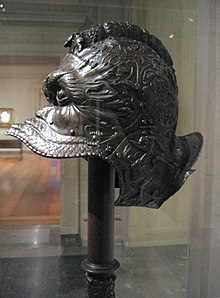Balaclava (helmet)
| Balaclava (helmet) | |
|---|---|

|
|
| Information | |
| Weapon type: | Protective weapon |
| Designations: | Balaclava, open balaclava, Burgonet, Bourginotte |
| Use: | helmet |
| Working time: | around 16th century |
| Region of origin / author: |
Europe , armory |
| Distribution: | Europe |
| Lists on the subject | |
The balaclava , also Burgonet (from French Bourguignotte ), was a type of helmet that developed from the Schaller at the beginning of the 16th century .
description
The balaclava is made of steel . The helmet bowl is rounded and in most cases has a strongly developed crest on the top of the helmet. In most cases an eyeshade is attached to the front. The cheek flaps of the helmet are usually movably riveted to the helmet bowl . In many versions, the helmet bowl is not made from one piece, but is made up of several parts and riveted to the upper helmet bowl. The balaclavas that do not have a visor are called "open balaclavas", those with a closed visor are called " closed balaclavas ". Most versions with a visor had a stake-out visor that could be removed when not in use.
The balaclava quickly became extremely popular and probably became the most widely worn helmet type of the 16th and 17th centuries - only the Morion was similarly widespread. It was first used by the infantry . The helmet quickly caught on , especially with troops armed with the pike in the Swiss style (for example Landsknechte ). Later, the balaclava also found its way into light riding, as it combined protection and freedom of view when deployed on horseback and when deployed on foot.
Versions

- Balaclava with three combs
One version of the balaclava is the "three-comb balaclava". Three steel combs are attached to the helmet shell. The largest is on the top line, the other two on the side in the upper area of the helmet. The combs are solidly processed and serrated on the upper edge. The combs were used to provide better protection against blows. The construction of the rest of the helmet is the same as that of normal balaclavas as described above.
- Sumptuous balaclavas
Also Italian balaclava . This version is available in many versions and different types. As a rule, they are not used for combat, but are used as parade helmets and representational objects. The representations range from simple engravings to highly artistic, figurative works such as by Filippo Negroli (approx. 1510–1579) from Milan , whose helmet and armor decorations are considered masterful work and in many art museums (e.g. Metropolitan Museum , New York) are on display.
Definition of terms
The called balaclava helmet is of the same name, also known as hate cap designated cap to distinguish.
literature
- Liliane Funcken , Fred Funcken : The age of chivalry. Volume 3: The Renaissance. Arms, horses and tournaments. Helmets and armor. Tactics and artillery. Prentice-Hall, Englewood Cliffs NJ 1983, ISBN 0-13-046334-5 .
- George Cameron Stone : A Glossary of the Construction, Decoration and Use of Arms and Armor in All Countries and in All Times. With an Introduction by Donald J. LaRocca. Courier Dover Publications, Mineola NY 1999, ISBN 0-486-40726-8 .
- John Tincey: Ironsides. English Cavalry, 1588–1688 (= Warrior Series 44). Osprey Publishing, Oxford 2002, ISBN 1-84176-213-X .
Web links
- Balaclava with three combs at Museum Syndikat
- Magnificent balaclava in the Metropolitan Museum / New York, Italian work for Cosimo II de 'Medici (1590–1621)
- Balaclava for an officer, Nuremberg around 1570
Individual evidence
- ^ Stone: A Glossary of the Construction. 1999, pp. 156-157.
- ^ Stone: A Glossary of the Construction. 1999, pp. 155-157.
- ↑ Filippo Negroli's pomp balaclava on the website of the Metropolitan Museum, New York (English, available online, accessed on July 19, 2011)

